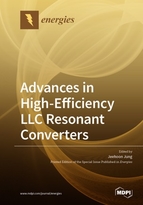Advances in High-Efficiency LLC Resonant Converters
A special issue of Energies (ISSN 1996-1073). This special issue belongs to the section "F: Electrical Engineering".
Deadline for manuscript submissions: closed (16 January 2020) | Viewed by 37262
Special Issue Editor
Interests: high-frequency DC–DC converters and switched-mode power supplies using wide band-gap devices; bidirectional and resonant power converters for smart power transformers; digital control and signal processing algorithms for power management; wireless power transfer techniques for home appliances and EVs; power conversion for renewable energy; and real-time and power hardware-in-the-loop (HIL) simulations of smart power grids and DC microgrids
Special Issue Information
Dear colleagues,
LLC resonant converters have been widely used in industrial fields because of their high efficiency, simple structure, and cost effectiveness. Nowadays, many advanced technologies and approaches have been introduced and propose to improve their power conversion efficiency, dynamic performance, stability, reliability, etc., using enhanced devices such as wide band-gap power switches and high-speed controllers. In addition, new and advanced control algorithms have been applied to the LLC resonant converters.
The Guest Editor is inviting submissions for a Special Issue of Energies on the subject area of "Advances in High-Efficiency LLC Resonant converters". This Special Issue will focus on emerging power electronic topologies related to the LLC resonant converters and their design methodologies and control algorithms. Topics of interest for publication include, but are not limited to:
- LLC Resonant Topologies;
- Design Methodologies of Resonant Tanks for High Efficiency;
- Power Loss Analysis in LLC Resonant Converters;
- High-Frequency Magnetics in LLC Resonant Converters;
- Wide Band-gap Devices Applied to LLC Resonant Converters;
- Advanced Control Algorithms for LLC Resonant Converters
Prof. Dr. Jeehoon Jung
Guest Editor
Manuscript Submission Information
Manuscripts should be submitted online at www.mdpi.com by registering and logging in to this website. Once you are registered, click here to go to the submission form. Manuscripts can be submitted until the deadline. All submissions that pass pre-check are peer-reviewed. Accepted papers will be published continuously in the journal (as soon as accepted) and will be listed together on the special issue website. Research articles, review articles as well as short communications are invited. For planned papers, a title and short abstract (about 100 words) can be sent to the Editorial Office for announcement on this website.
Submitted manuscripts should not have been published previously, nor be under consideration for publication elsewhere (except conference proceedings papers). All manuscripts are thoroughly refereed through a single-blind peer-review process. A guide for authors and other relevant information for submission of manuscripts is available on the Instructions for Authors page. Energies is an international peer-reviewed open access semimonthly journal published by MDPI.
Please visit the Instructions for Authors page before submitting a manuscript. The Article Processing Charge (APC) for publication in this open access journal is 2600 CHF (Swiss Francs). Submitted papers should be well formatted and use good English. Authors may use MDPI's English editing service prior to publication or during author revisions.
Keywords
- LLC Resonant Converters, High Efficiency
- Power Loss
- Resonant Tank Design
- High-Frequency Magnetics
- Wide Band-gap Devices
- Control in Resonant Converters






